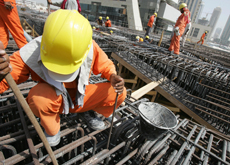Dubai's missing cranes and fleeing Indians
 Industrial cranes, a ubiquitous sight on the UAE and dubbed its national bird, have stopped flying. A third of the crane population, working non-stop on high-rise buildings, have been grounded - their wings clipped by the global meltdown. A decade's construction boom having suddenly gone bust, over one lakh people, mostly expatriates, have lost their jobs.
Industrial cranes, a ubiquitous sight on the UAE and dubbed its national bird, have stopped flying. A third of the crane population, working non-stop on high-rise buildings, have been grounded - their wings clipped by the global meltdown. A decade's construction boom having suddenly gone bust, over one lakh people, mostly expatriates, have lost their jobs.
S Muthuraman, a construction worker from Tamil Nadu, sold his wife's ornaments so that he could pay the travel agents who, he believed, will take him to a more prosperous future in Dubai. Today, with construction activity having come to a standstill, he has been asked to leave the UAE. "I have a debt of Rs86,000 and I am returning to India with Rs5,000 in my hand," he says.
Calicut's Madhusudhan Nair, a qualified lift engineer, is another victim of the meltdown in Dubai. The company he worked for is a sub-contractor for Nakheel, a construction major, which dumped 500 people last month, followed by another 300 this month. Despite having worked for his company for more than 10 years, he was laid off because Nakheel terminated the contract with his employer. Today Nair is out looking for a job in Mumbai as there is not much demand for lift engineers in Kerala at the moment.
Muthuraman and Nair are just two of the 2.3 million Indians in the UAE who are facing an uncertain future, with the Dubai economy in a free fall. Mohan Nair, editor of Dubai's Property Weekly, says that at least 40 per cent of construction activity in Dubai has been indefinitely put off, rendering thousands of Indians jobless. In fact, even Property Weekly - the leading publication on real estate in the region - has shrunk from 300 to 80 pages. And if the cancellation of power connections and work visas are any indication, around 1,300-1,500 people are leaving Dubai and Sharjah every day, returning to India and Sri Lanka (the worst affected among expatriates).
In its latest research report, the Economic Intelligence Unit (EIU) has said that Dubai's population could fall by 8 per cent, which, in turn, could lead to its construction and real estate work force getting slashed by as much as 25 per cent in 2009. In fact, more than 1,00,000 Indian and Lankan workers have already left the UAE.
Earlier last week, Majid Al Futtaim, the country's largest employer after the govt, announced a 10 per cent staff cut. WS Atkins, a leading consultancy firm, laid off 190 professionals early this month. Among other companies who trimmed the flab were Better Homes (150), Al Shafar (1,200) Dulsco (900), Tamweer (260), Tatweer (150), Damac (300) and WSP (90).
DNA had reported on Jan 14 that more than 3,000 cars had been abandoned in parking lots by debt-ridden foreigners, mostly Indians, exiting the country. Indian high school authorities in Dubai believe that the situation will worsen after March 2009, when the schools have their holidays. According to them, a lot of parents have applied for TC (Transfer Certificates) for their wards so that they can return and seek admission back in their home country. As for the Dubai stock market, it fell by 72 per cent last year, while the Abu Dhabi market fell by 47.5 per cent during the same period.
To control the problem, the Dubai executive council has approved part-time jobs as an optional system in all government bodies. The government has also pumped in
31.7 billion Dhirams. But unless the construction boom of the last decade is revived, it won't affect the Indian workers in the UAE.